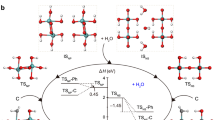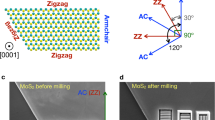Abstract
Controlling surface structure at the atomic scale is paramount to developing effective catalysts. For example, the edge sites of MoS2 are highly catalytically active and are thus preferred at the catalyst surface over MoS2 basal planes, which are inert. However, thermodynamics favours the presence of the basal plane, limiting the number of active sites at the surface. Herein, we engineer the surface structure of MoS2 to preferentially expose edge sites to effect improved catalysis by successfully synthesizing contiguous large-area thin films of a highly ordered double-gyroid MoS2 bicontinuous network with nanoscaled pores. The high surface curvature of this catalyst mesostructure exposes a large fraction of edge sites, which, along with its high surface area, leads to excellent activity for electrocatalytic hydrogen evolution. This work elucidates how morphological control of materials at the nanoscale can significantly impact the surface structure at the atomic scale, enabling new opportunities for enhancing surface properties for catalysis and other important technological applications.
This is a preview of subscription content, access via your institution
Access options
Subscribe to this journal
Receive 12 print issues and online access
$259.00 per year
only $21.58 per issue
Buy this article
- Purchase on Springer Link
- Instant access to full article PDF
Prices may be subject to local taxes which are calculated during checkout






Similar content being viewed by others
References
Eda, G. et al. Photoluminescence from chemically exfoliated MoS2 . Nano Lett. 11, 5111–5116 (2011).
Splendiani, A. et al. Emerging photoluminescence in monolayer MoS2 . Nano Lett. 10, 1271–1275 (2010).
Wilcoxon, J. P. & Samara, G. A. Strong quantum-size effects in layered semiconductor: MoS2 nanoclusters. Phys. Rev. B 51, 7299–7302 (1995).
Kis, A. et al. Shear and Young’s moduli of MoS2 nanotube ropes. Adv. Mater. 15, 733–736 (2003).
Rosentsveig, R. et al. Fullerene-like MoS2 nanoparticles and their tribological behavior. Tribol. Lett. 36, 175–182 (2009).
Radisavljevic, B., Radenovic, A., Brivio, J., Giacometti, V. & Kis, A. Single-layer MoS2 transistors. Nature Nanotech. 6, 147–150 (2011).
Chen, J., Li, S-L., Xu, Q. & Tanaka, K. Synthesis of open-ended MoS2 nanotubes and the application as the catalyst of methanation. Chem. Commun. 1722–1723 (2002).
Dominko, R. et al. Dichalcogenide nanotube electrodes for Li-ion batteries. Adv. Mater. 14, 1531–1534 (2002).
Topsøe, H., Clausen, B. S. & Massoth, F. E. Hydrotreating Catalysis, Science and Technology Vol. 11 (Springer, 1996).
Chhowalla, M. & Amaratunga, G. A. J. Thin films of fullerene-like MoS2 nanoparticles with ultra-low friction and wear. Nature 407, 164–167 (2000).
Wilcoxon, J. P., Thurston, T. R. & Martin, J. E. Applications of metal and semiconductor nanoclusters as thermal and photo-catalysts. Nanostruct. Mater. 12, 993–997 (1999).
Abrams, B. L. & Wilcoxon, J. P. Nanosize semiconductors for photooxidation. Crit. Rev. Solid State Mater. Sci. 30, 153–182 (2005).
Kline, G., Kam, K. K., Ziegler, R. & Parkinson, B. A. Further studies of the photoelectrochemical properties of the group VI transition metal dichalcogenides. Sol. Energy Mater. 6, 337–350 (1982).
Gourmelon, E. et al. MS2 (M = W, Mo) photosensitive thin films for solar cells. Sol. Energy Mater. Sol. Cells 46, 115–121 (1997).
Jaramillo, T. F. et al. Identification of active edge sites for electrochemical H2 evolution from MoS2 nanocatalysts. Science 317, 100–102 (2007).
Li, Y. et al. MoS2 nanoparticles grown on graphene: An advanced catalyst for the hydrogen evolution reaction. J. Am. Chem. Soc. 133, 7296–7299 (2011).
Merki, D., Fierro, S., Vrubel, H. & Hu, X. L. Amorphous molybdenum sulfide films as catalysts for electrochemical hydrogen production in water. Chem. Sci. 2, 1262–1267 (2011).
Chen, Z. et al. Core–shell MoO3–MoS2 nanowires for hydrogen evolution: A functional design for electrocatalytic materials. Nano Lett. 11, 4168–4175 (2011).
Hinnemann, B. et al. Biomimetic hydrogen evolution: MoS2 nanoparticles as catalyst for hydrogen evolution. J. Am. Chem. Soc. 127, 5308–5309 (2005).
Bonde, J., Moses, P. G., Jaramillo, T. F., Norskov, J. K. & Chorkendorff, I. Hydrogen evolution on nano-particulate transition metal sulfides. Faraday Discuss. 140, 219–231 (2008).
Zong, X. et al. Enhancement of photocatalytic H2 evolution on CdS by loading MoS2 as cocatalyst under visible light irradiation. J. Am. Chem. Soc. 130, 7176–7177 (2008).
Kanda, S., Akita, T., Fujishima, M. & Tada, H. Facile synthesis and catalytic activity of MoS2/TiO2 by a photodeposition-based technique and its oxidized derivative MoO3/TiO2 with a unique photochromism. J. Colloid Interface Sci. 354, 607–610 (2011).
Sobczynski, A. Molybdenum disulfide as a hydrogen evolution catalyst for water photodecomposition on semiconductors. J. Catal. 131, 156–166 (1991).
Albu-Yaron, A. et al. MoS2 hybrid nanostructures: From octahedral to quasi-spherical shells within individual nanoparticles. Angew. Chem. Int. Ed. 50, 1810–1814 (2011).
Wei, T. C. & Hillhouse, H. W. Mass transport and electrode accessibility through periodic self-assembled nanoporous silica thin films. Langmuir 23, 5689–5699 (2007).
Shi, Y. F., Wan, Y., Liu, R. L., Tu, B. & Zhao, D. Y. Synthesis of highly ordered mesoporous crystalline WS2 and MoS2 via a high-temperature reductive sulfuration route. J. Am. Chem. Soc. 129, 9522–9531 (2007).
Skrabalak, S. E. & Suslick, K. S. Porous MoS2 synthesized by ultrasonic spray pyrolysis. J. Am. Chem. Soc. 127, 9990–9991 (2005).
Alonso, G. et al. Characterization and HDS activity of mesoporous MoS2 catalysts prepared by in situ activation of tetraalkylammonium thiomolybdates. J. Catal. 208, 359–369 (2002).
Polyakov, M. et al. Carbon-stabilized mesoporous MoS2—Structural and surface characterization with spectroscopic and catalytic tools. Catal. Commun. 12, 231–237 (2010).
Walcarius, A., Sibottier, E., Etienne, M. & Ghanbaja, J. Electrochemically assisted self-assembly of mesoporous silica thin films. Nature Mater. 6, 602–608 (2007).
Nicole, L., Boissiere, C., Grosso, D., Quach, A. & Sanchez, C. Mesostructured hybrid organic-inorganic thin films. J. Mater. Chem. 15, 3598–3627 (2005).
Tate, M. P., Urade, V. N., Gaik, S. J., Muzzillo, C. P. & Hillhouse, H. W. How to dip-coat and spin-coat nanoporous double-gyroid silica films with EO19–PO43–EO19 surfactant (Pluronic P84) and know it using a powder x-ray diffractometer. Langmuir 26, 4357–4367 (2010).
McEvoy, T. M. & Stevenson, K. J. Elucidation of the electrodeposition mechanism of molybdenum oxide from iso- and peroxo-polymolybdate solutions. J. Mater. Res. 19, 429–438 (2004).
Lee, C. et al. Anomalous lattice vibrations of single- and few-layer MoS2 . ACS Nano 4, 2695–2700 (2010).
Windom, B. C., Sawyer, W. G. & Hahn, D. W. A Raman spectroscopic study of MoS2 and MoO3: applications to tribological systems. Tribol. Lett. 42, 301–310 (2011).
Porod, G. in Small Angle X-Ray Scattering (eds Glatter, O. & Kratky, O.) (Academic, 1982).
Tributsch, H. & Bennett, J. C. Electrochemistry and photochemistry of MoS2 layer crystals. J. Electroanal. Chem. 81, 97–111 (1977).
Jaramillo, T. F. et al. Hydrogen evolution on supported incomplete Cubane-type Mo3S4 (+4) electrocatalysts. J. Phys. Chem. C 112, 17492–17498 (2008).
Yadgarov, L. et al. Controlled doping of MS2 (M = W, Mo) nanotubes and fullerene-like nanoparticles. Angew. Chem. Int. Ed. 51, 1148–1151 (2012).
Chianelli, R. R. et al. The reactivity of MoS2 single crystal edge planes. J. Catal. 92, 56–63 (1985).
Prins, R. in Handbook of Heterogeneous Catalysis (eds Ertl, G., Knözinger, H. & Weitkamp, S. F.) 2695–2718 (Wiley, 2008).
Tuxen, A. et al. Size threshold in the dibenzothiophene adsorption on MoS2 nanoclusters. ACS Nano 4, 4677–4682 (2010).
Lauritsen, J. V. et al. Chemistry of one-dimensional metallic edge states in MoS2 nanoclusters. Nanotechnology 14, 385–389 (2003).
Lauritsen, J. V. et al. Hydrodesulfurization reaction pathways on MoS2 nanoclusters revealed by scanning tunneling microscopy. J. Catal. 224, 94–106 (2004).
Prins, R., de Beer, V. H. J. & Somorjai, G. A. Structure and Function of the Catalyst and the Promoter in Co–Mo Hydrotreating Catalysts. Catal. Rev. Sci. Eng. 31, 1–41 (1989).
Topsøe, H. & Clausen, B. S. Importance of Co–Mo–S type structures in hydrodesulfurization. Catal. Rev.: Sci. Eng. 26, 395–420 (1984).
Kibsgaard, J. et al. Comparative atomic-scale analysis of promotional effects by late 3d-transition metals in MoS2 hydrotreating catalysts. J. Catal. 272, 195–203 (2010).
Lauritsen, J. V. et al. Location and coordination of promoter atoms in Co- and Ni-promoted MoS2-based hydrotreating catalysts. J. Catal. 249, 220–233 (2007).
Besenbacher, F. et al. Recent STM, DFT and HAADF-STEM studies of sulfide-based hydrotreating catalysts: Insight into mechanistic, structural and particle size effects. Catal. Today 130, 86–96 (2008).
Merki, D., Vrubel, H., Rovelli, L., Fierro, S. & Hu, X. Fe, Co, and Ni ions promote the catalytic activity of amorphous molybdenum sulfide films for hydrogen evolution. Chem. Sci. 3, 2515–2525 (2012).
Acknowledgements
All physical and electrochemical characterization was supported by the Center on Nanostructuring for Efficient Energy Conversion at Stanford University, an Energy Frontier Research Center funded by the US Department of Energy, Office of Science, Office of Basic Energy Sciences under award number DE-SC0001060. Early stage development of the synthetic procedure to obtain double-gyroid MoS2 was supported by the US Department of Energy, Office of Energy Efficiency & Renewable Energy, under subcontract NFT-9-88567-01 under Prime Contract No. DE-AC36-08GO28308. We thank J. Opatkiewicz for assistance with Raman spectroscopy measurements and BASF for generously providing the surfactant Pluronic P84. We also thank J. Benck and P. C. K. Vesborg for helpful discussion. J.K. gratefully acknowledges the Villum Kann Rasmussen Foundation for a postdoctoral fellowship.
Author information
Authors and Affiliations
Contributions
J.K. and Z.C. carried out synthesis of the double-gyroid MoS2 and performed XPS, XRD, SEM, Raman and electrochemical measurements. B.N.R. performed TEM imaging. J.K., Z.C. and T.F.J. conceived the study and wrote the manuscript.
Corresponding author
Ethics declarations
Competing interests
The authors declare no competing financial interests.
Supplementary information
Supplementary Information
Supplementary Information (PDF 1740 kb)
Rights and permissions
About this article
Cite this article
Kibsgaard, J., Chen, Z., Reinecke, B. et al. Engineering the surface structure of MoS2 to preferentially expose active edge sites for electrocatalysis. Nature Mater 11, 963–969 (2012). https://doi.org/10.1038/nmat3439
Received:
Accepted:
Published:
Issue Date:
DOI: https://doi.org/10.1038/nmat3439
This article is cited by
-
The reformation of catalyst: From a trial-and-error synthesis to rational design
Nano Research (2024)
-
MoO2-MoS2 composite coated with polyaniline as an anode material for high-performance lithium ion batteries
Ionics (2024)
-
Spectroscopic signature of obstructed surface states in SrIn2P2
Nature Communications (2023)
-
In situ acid etching boosts mercury accommodation capacities of transition metal sulfides
Nature Communications (2023)
-
Mimicking reductive dehalogenases for efficient electrocatalytic water dechlorination
Nature Communications (2023)



